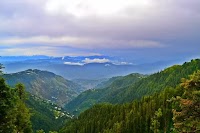This world's largest fort is located in Jasmshoro Distirct of Sindh, Pakistan, at a distance of 90 km from the Hyderabad city. This is also known as great wall of Sindh. Its wall are made of gypsum and lime cut sandstone, with an average height of 6 meters.
Ranikot is the most talismanic wonder of Pakistan and Sindh Province. Visible from five kilometers, its massive undulating walls twist and dip over the hills. With the circumference of about twenty kilometers, its walls, built with dressed sandstone and reinforced with 45 bastions along the outer wall, of which 7 are rectangular and the remaining are round. All modified through the ages to accommodate the use of gunpowder, this perhaps makes it the largest fort in the world.
Most of the twenty six kilometers long wall is made of natural cliffs and mountains which at places rise as high as two thousand feet above sea level. Only about 8.25 km portions of its wall are man-made, built with yellow sandstone. This was first measured on foot by Badar Abro along with local guideSadiq Gabol. As one enters the fort, one can find hills, valleys, streams, ditches, ponds, pools, fossils, building structure, bastions, watchtowers, ammunition depots, fortresses - all inside Ranikot, adding more to its beauty and mystery. A spring emerging from an underground water source near the Mohan Gate is named as 'Parryen jo Tarr' (the spring of fairies).
According to a tale told by the local inhabitants, fairies come from far and wide on the Ponam Nights (full moon) to take bath at this spring near 'Karo Jabal'! Splashing sounds of water falling on the rocks can be heard at another spring, Waggun jo Tarr or "the Crocodile Spring", named so as crocodiles once lived there.
Within Ranikot, there are two more fortresses, Meeri and Shergarh, each have five bastions. Meerikot takes its name from the word 'Mir' meaning top (for instance the top of a hill, chief of any Baloch tribe, etc.). M.H. Panhwar (a Sindhologist) disagrees upon the name's history being related to Mirs of Sindh, stating that "Of two forts inside the main Rani Kot fort, the lower one is called Miri and is a word used in Seistan for small fortress. It has nothing to do with Mirs of Sindh. Both the main Ranikot and the inner Meerikot have similar entrances - curved, angulated with a safe tortuous path. From the military point of view, Meerikot is located at a very safe and central place in the very heart of the Ranikot with residential arrangements including a water-well.





